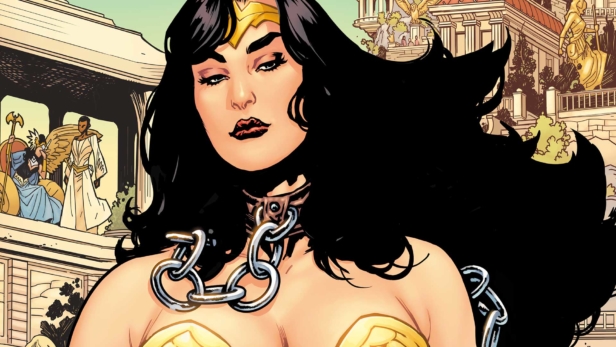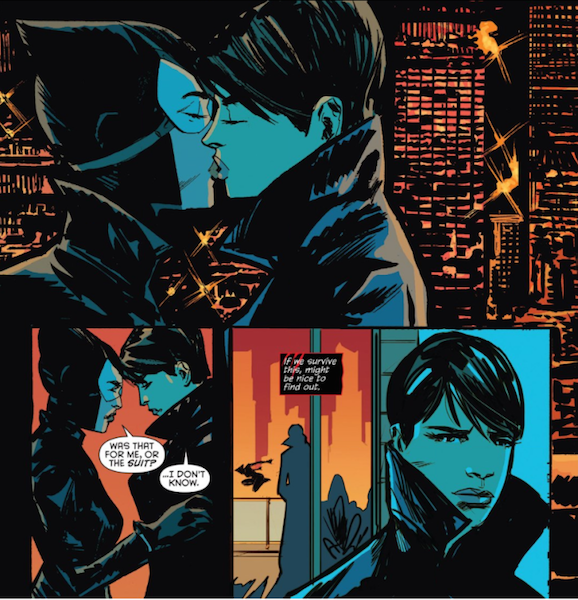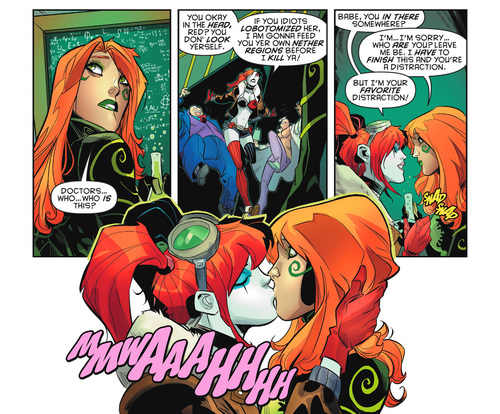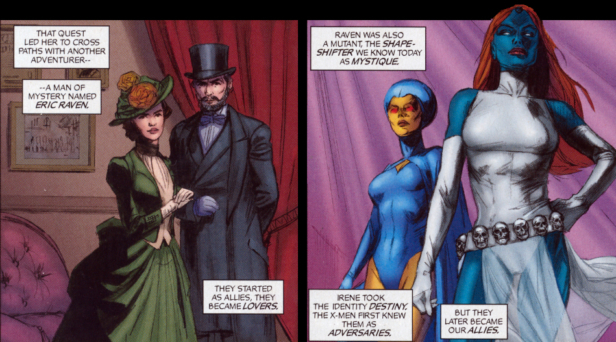With the Amazonian princess taking our cinemas by storm, Hope Nicholson and Karen K. Burrows think it’s about time we explored comic books’ female screen stars and their sexuality, and why they’re not just here to be some guy’s eye candy. Let’s be Straight: Wonder Woman is into Women.
Wonder Woman, Catwoman, Mystique, Harley Quinn, and Poison Ivy are names that even non-comic book fans can identify, thanks to their films.
Aside from being leading ladies of comics (Catwoman, the oldest at 77 years old, our pal Harley Quinn a millennial baby at just 24 years old), each of these characters have another thing in common: they’re bisexual in the pages of (some) of their comics, but not yet identified as such in their movie counterparts.
Despite increased representation in the source comics, more recognizable queer characters rarely cross that barrier to film. Representation matters in every form – but blockbuster films have a greater reach than comics. Confirming in worldwide media that characters who have been part of the popular consciousness for decades can also be queer would be a true step forward!
Let’s take a closer look at the queer history of these characters and think about what might have been – and what still could!
Catwoman
First appearance: 1940
Catwoman, aka Selina Kyle, roguish thief of hearts, began her career as a simple femme fatale foil to Batman. A character too charming to lose, Catwoman has appeared time and again as Batman’s ally, enemy, or love interest. Catwoman’s coming out happened in 2015, when writer Genevieve Valentine and artist Garry Brown showcased a passionate kiss between her and a new character, Eiko.
But in the film universes (played by Michelle Pfeiffer, Halle Berry, and Anne Hathaway), Catwoman is just Batman’s teasing lover. It’s hard not to define Catwoman in relation to Batman, but Valentine’s comics give Selina more autonomy in her role as one of Gotham’s foremost crime bosses – and confirming her bisexuality helps shore up an identity other than ‘Batman’s girlfriend.’
It’s worth noting that the similarly named-and themed-Spider-Man character Black Cat is also openly bisexual and set to star in the upcoming Silver & Black film.
Harley Quinn & Poison Ivy
First appearance: 1993, 1966
A two-fer, not only are these characters canonically queer, but also happily in a polyamorous coupling together.
Shortly after Harley Quinn breaks up with the Joker, she joins forces with Batman foe Poison Ivy. From here on out, they are bound together as the ultimate bad gal-pal team. Yep – that kind of gal-pal: in 2009, Harley confronted Ivy about the nature of their relationship, making it canon. Since then, they’ve been physically intimate on the page in a way that most queer comic characters never get to be, though other lovers come in and out of their lives.
Creators like Paul Dini recognized the subtext and played to it deliberately; though many media properties queer bait or refuse to follow up when a connection develops, Harley and Ivy have become steadily more meaningful as a couple over time. As Joker’s treatment of Harley gets more abusive, Ivy is portrayed as her safe haven. To see a queer relationship as healthy and positive is hugely important.
Though the characters both have film counterparts (Poison Ivy in the campy 1997 Batman & Robin film played by Uma Thurman, Harley Quinn, energetically malicious in the 2016 Suicide Squad film by Margot Robbie), neither have appeared in live-action movies together.
Will the upcoming Gotham City Sirens film stay true to its comics origins and include Harley and Ivy’s romantic and sexual relationship? So far all we have is speculation (and a whole lot of established merchandise celebrating the Harley-Joker relationship).
Mystique
First appearance: 1978
In the 1980s, Marvel policy banned explicit queer representation, which meant writer Chris Claremont had to show Mystique’s relationship with her elderly teammate Destiny subtly. Yet, it was probably the most stable, least dramatic relationship in X-Men history. Theirs was a delightfully queer relationship, with Mystique’s shapeshifting genderfluidity no barrier; though they were parted many times over their years together, their connection remained. Despite its restrictive origin, the quiet strength of the relationship became a strong base for Mystique, demonstrating the humanity behind her often monstrous acts. Mystique has been portrayed twice in the X-Men film universe, first by Rebecca Romijn, then more recently by Jennifer Lawrence, but though her gender-shifting has been retained, we’ve seen no hints of her bisexuality, and Destiny hasn’t appeared at all.
Wonder Woman
First appearance: 1941
On the surface it seems strikingly straight-forward: Wonder Woman swears by patron lesbian poet “Suffering Sappho!” And in George Perez’s 1988 reboot we learn most Amazons “find satisfaction in each other” (or choose “the way of Narcissus”… ahem). Greg Rucka teases in 2003 when Diana replies to a question about whether she has a boyfriend, adding “I don’t have a girlfriend, either… I’m not really looking right now,” while Gail Simone’s 2007 run includes a throwaway line referring to Amazonian courtship rituals as traditionally conducted between two women. Yet none of this answers whether Diana herself has had a girlfriend. She is explicitly queer in Grant Morrison and Yanick Paquette’s 2016 Wonder Woman: Earth One graphic novel – but their alternate universe is non-canonical (and very different).
In the pages of Wonder Woman: Year One by Rucka and Nicola Scott (2016), Diana shares many loving moments with fellow Amazon Kasia, affectionately embracing her and shedding a tearful goodbye. Other Amazons gossip about Diana’s love life, including the many women she’s been with! “Absolutely, yes,” Rucka confirms: this Diana has had romantic relationships with women.
Gal Gadot, star of the Wonder Woman film, agrees, stating publicly that she hopes Halle Berry plays her love interest in the film’s potential sequel. For Diana, Gadot says, gender doesn’t matter: love is central to her character and she sees no reason to limit it.
Wonder Woman is probably the best-known female superhero in the world, yet her queerness has previously been subtle at best and easy to overlook. Now it has been portrayed unambiguously, and has received enough media coverage that it is unlikely to be retconned. This recognition is long overdue – and it means one of the most popular comics characters is a queer woman, which sends a great message of inclusivity and welcome. Let’s hope both the comics and her film adaptations will give her the confidence to showcase her lady-loves with more than a chaste kiss on the cheek.
Hope Nicholson is the author of The Spectacular Sisterhood of Superwomen, which is out now from @Quirkbooks.




